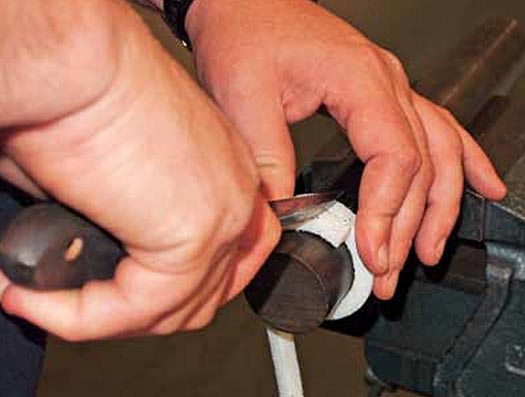Mechanical packing is a versatile sealing device. One of the best features of braided mechanical packing in roll form is its flexibility and ease of use. In today’s world of maximizing plant efficiency with limited maintenance resources, some important steps to follow when installing packing are often overlooked. One of these is properly cutting the braided packing.
One of the best ways to enhance packing life is to focus on installation. After packing is installed, a few fixes can prolong life when a leak has occurred. As Ben Franklin stated, “An ounce of prevention is worth a pound of a cure.” This is true about packing, since installation is the key to long packing life. Cutting packing rings incorrectly can result in a low mean time between failure (MTBF) for valves and pumps and is easily preventable with some basic training. This article discusses some fundamental concepts to improve packing life by properly cutting the rings.
Important Steps
The best way to cut packing accurately is to focus on a few simple steps:
- Use a mandrel to cut rings
- Use a sharp knife
- Use a forceful cutting motion
Sometimes, bad habits that are developed when cutting packing rings can start at a plant and can severely limit packing performance. Training and education will help prevent bad maintenance practices and provide understanding of the importance of the task. Unacceptable practices for cutting packing rings can be handed down from technician to technician because it is hard to see the effect that it has on the sealing failure of the equipment.
Sizing
One of the more prevalent practices is using the packing rings that were removed when unpacking a valve or a pump as a length guide for cutting the new rings. The problem is the rings that were removed could have been incorrectly sized the last time so the error will just be repeated. Also, the rings that are unpacked might have been chemically attacked and may have shrunk or become deformed while in service.
The most accurate way to cut packing rings is to use a mandrel that is the exact size of the shaft or stem. By taking the mandrel and placing it in a vice and wrapping the packing around it, an accurate length can be determined for the packing ring.
Cutting
The rings should either be cut on the mandrel at a 45-degree angle for a skive cut or a 5-degree, almost-straight cut for a butt cut. Check the installation instructions of the packing manufacturer for the correct cutting type required by the application. Rings should be held tightly on the mandrel but not stretched. When cutting skive joints, a mitre board should be used so that each successive ring can be cut at the correct angle.
After each ring is cut, it should be wrapped around the mandrel as a double check to ensure that the ends adjoin with each other. This is similar to a “go/no-go” gauge. Skilfully cutting rings with a mandrel does take some practice of the packing pulling and the wrapping technique. Focusing on the end result of the ring fitting on the mandrel with no gap will quickly provide a feedback loop to perfect the practice. Each style of packing will pull around the mandrel slightly differently.
Figure 2. Cutting on a mandrel
Unravelling Ends
Another issue to watch for is trimming rings that have been cut long. Cutting a small section of one of the packing ends can result in the packing unravelling—a major failure point when it is installed. If this happens, the damaged ring should be scrapped, and another ring should be cut, concentrating on getting the size correct.
Tools
The second component to an accurately cut packing ring is the tools that are used. Another major poor practice is using a pocket knife to cut packing rings. A number of major issues can arise from using this type of cutting tool.
The first problem is that most knives are not very sharp, and a dull knife will make the cutter use a back and forth cutting motion instead of clean slice of the packing. This back and forth motion causes the packing to open up (bloom) making installation and sealing more difficult. A sharp knife makes a clean cut that keeps the strands together in the original shape. Cutting packing will dull any type of knife quickly, so make sure there is easy access to knife sharpeners.
The second issue with using a pocket knife is the lack of a good grip. When cutting packing, a considerable amount of force must be applied to cut in one stroke, and without a good handle, this is much harder to accomplish. It is very important that the tool used to cut packing is a straight edge blade and not serrated. This will also help reach the goal of a clean cut without deformed packing ends.
The correct way to cut packing is to have the knife at an angle to the packing (handle higher) and not parallel to it. This method results in better leverage on the packing resulting in a better cut. Many tutorials are available that highlight this method when cutting in the kitchen. Correctly cutting a piece of packing is very similar to cutting in a professional kitchen
Excess Material
Cutting packing will always results in some waste. This could be rings that are too long or short but also can be rings whose ends have unravelled or blossomed to the point at which they could result in a leak path. One of the easiest ways to sidestep errors in cutting is to order cut rings from the packing supplier. Besides no scrap, there is also a considerable time savings from not having to cut the rings. The drawbacks to using cut rings everywhere is having good documentation of the actual size of the packing beforehand to know what to order. This can be a bigger hurdle than first thought since a major paradigm shift needs to occur regarding creating a database of equipment dimensions.
Conclusion
A couple of other simple ways to create a good environment that will result in a better cut ring are first to order (or get a machine shop to create) accurate mandrels for all stem and shaft sizes. The other is to have in the cut ring area some good knives and access to a knife sharpener
Written by Ron Frisard of the AW Chesterton Company







